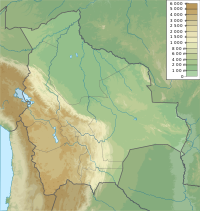
Omasuyos or Uma Suyu is a province in the La Paz Department in Bolivia. Its capital is Achacachi.

Nazacara or Nasa Q'ara is a village in the La Paz Department in Bolivia. It is the seat of the Nazacara Canton in the San Andrés de Machaca Municipality which is the fifth municipal section of the Ingavi Province.

Utani Apu (Aymara) is a 4,060 m (13,320 ft) mountain in the Andes of Bolivia. It is located in the La Paz Department, Ingavi Province, San Andrés de Machaca Municipality, and in the Pacajes Province, Caquiaviri Municipality.

Muru Qullu is a 4,613-metre-high (15,135 ft) mountain in Bolivia. It is located in the Potosí Department, Antonio Quijarro Province, Porco Municipality. It lies southwest of Warawara Lake.

P'utu P'utu is a mountain in the Bolivian Andes which reaches a height of approximately 4,880 m (16,010 ft). It is located in the Cochabamba Department, Quillacollo Province, Quillacollo Municipality. P'utu P'utu lies west of Jatun Kimray Punta.

Qina Qina is a mountain in the Bolivian Andes which reaches a height of approximately 4,800 m (15,700 ft). It is located in the Cochabamba Department, Quillacollo Province, Quillacollo Municipality, at the border of the Morochata Municipality.

Wila Qullu Punta is a 4,739-metre-high (15,548 ft) mountain in the Bolivian Andes. It is located in the Cochabamba Department, Quillacollo Province, Quillacollo Municipality.

Qiñwani is a mountain in the Bolivian Andes which reaches a height of approximately 4,360 m (14,300 ft). It is located in the Cochabamba Department, Quillacollo Province, on the border of the Sipe Sipe Municipality and the Vinto Municipality. Qiñwani lies northwest of Yana Qaqa.

Puka Qawiña is a 3,512-metre-high (11,522 ft) mountain in the Bolivian Andes. It is located in the Cochabamba Department, at the border of the Esteban Arce Province, Anzaldo Municipality, and the Mizque Province, Vila Vila Municipality. Puka Qawiña lies southeast of Tikrasqa, east of the village of Puka Pampa (Puca Pampa).

Pukara is a mountain in the Bolivian Andes which reaches a height of approximately 3,760 m (12,340 ft). It is located in the Cochabamba Department, Esteban Arce Province, Sacabamba Municipality. Pukara lies southwest of Atuq Wachana and northwest of Jatun Urqu, southwest of the village of Yana Rumi.

Qutani is a 3,482-metre-high (11,424 ft) mountain in the Bolivian Andes. It is located in the Cochabamba Department, Carrasco Province, Pocona Municipality. Qutani lies south of the UNESCO World Heritage Site of Inkallaqta, north of the village of Pocona. The next peak to the southeast is Qucha Qucha.

P'isaqa is a mountain in the Bolivian Andes which reaches a height of approximately 3,200 m (10,500 ft). It is located in the Cochabamba Department, Carrasco Province, Pocona Municipality. It lies at the Wanaku Mayu.

Misk'i is a mountain in the Bolivian Andes which reaches a height of approximately 2,880 m (9,450 ft). It is located in the Cochabamba Department, Carrasco Province, Pocona Municipality. It lies at the Wanaku Mayu.

Layqa is a mountain in the Bolivian Andes which reaches a height of approximately 2,960 m (9,710 ft). It is located in the Cochabamba Department, Carrasco Province, Pocona Municipality.

Chhijmuni is a 2,830-metre-high (9,280 ft) mountain in the Bolivian Andes. It is located in the Cochabamba Department, on the border of the Campero Province, Aiquile Municipality, and the Mizque Province, Mizque Municipality, southeast of Mizque. It lies south of the peak of Juch'uy Chhijmuri. The Chhijmuri Mayu originates east of the peak. It flows to the east.

Wila Chullpa is a mountain in the Andes of Bolivia which reaches a height of approximately 4,380 m (14,370 ft). It is located in the Oruro Department, on the border of the Nor Carangas Province and the San Pedro de Totora Province, northeast of the village of Huacanapi.

Ch'usiqani is a 3,612-metre-high (11,850 ft) mountain in the Bolivian Andes. It is located in the Chuquisaca Department, Oropeza Province, Poroma Municipality.

Lluxita is a mountain in the Bolivian Andes which reaches a height of approximately 4,100 m (13,500 ft). It is located in the Potosí Department, Chayanta Province, Ocurí Municipality. It lies southeast of the village of Ch'aki Mayu (Chaqui Mayu).

Chullunkhäni is a 4,168-metre-high (13,675 ft) mountain in the Bolivian Andes. It is located in the Chuquisaca Department, Azurduy Province, Tarvita Municipality, and in the Jaime Zudáñez Province, Icla Municipality.

Qillqata is a 3,794-metre-high (12,448 ft) mountain in the Bolivian Andes. It is located in the Chuquisaca Department, Nor Cinti Province, San Lucas Municipality, near the border to the Potosí Department, José María Linares Province, Puna Municipality. It lies southeast of Otavi (Utawi).







